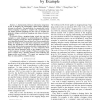Free Online Productivity Tools
i2Speak
i2Symbol
i2OCR
iTex2Img
iWeb2Print
iWeb2Shot
i2Type
iPdf2Split
iPdf2Merge
i2Bopomofo
i2Arabic
i2Style
i2Image
i2PDF
iLatex2Rtf
Sci2ools
217
click to vote
ICDE
2008
IEEE
2008
IEEE
Muse: Mapping Understanding and deSign by Example
A fundamental problem in information integration is that of designing the relationships, called schema mappings, between two schemas. The specification of a semantically correct schema mapping is typically a complex task. Automated tools can suggest potential mappings, but few tools are available for helping a designer understand mappings and design alternative mappings. We describe Muse, a mapping design wizard that uses data examples to assist designers in understanding and refining a schema mapping towards the desired specification. We present novel algorithms behind Muse and show how Muse systematically guides the designer on two important components of a mapping design: the specification of the desired grouping semantics for sets of data and the choice among alternative interpretations for semantically ambiguous mappings. In every component, Muse infers the desired semantics based on the designer's actions on a short sequence of small examples. Whenever possible, Muse draws e...
Database | Design Alternative Mappings | Designer Understand Mappings | ICDE 2008 | Muse Draws Examples |
| Added | 01 Nov 2009 |
| Updated | 01 Nov 2009 |
| Type | Conference |
| Year | 2008 |
| Where | ICDE |
| Authors | Bogdan Alexe, Laura Chiticariu, Renée J. Miller, Wang Chiew Tan |
Comments (0)

